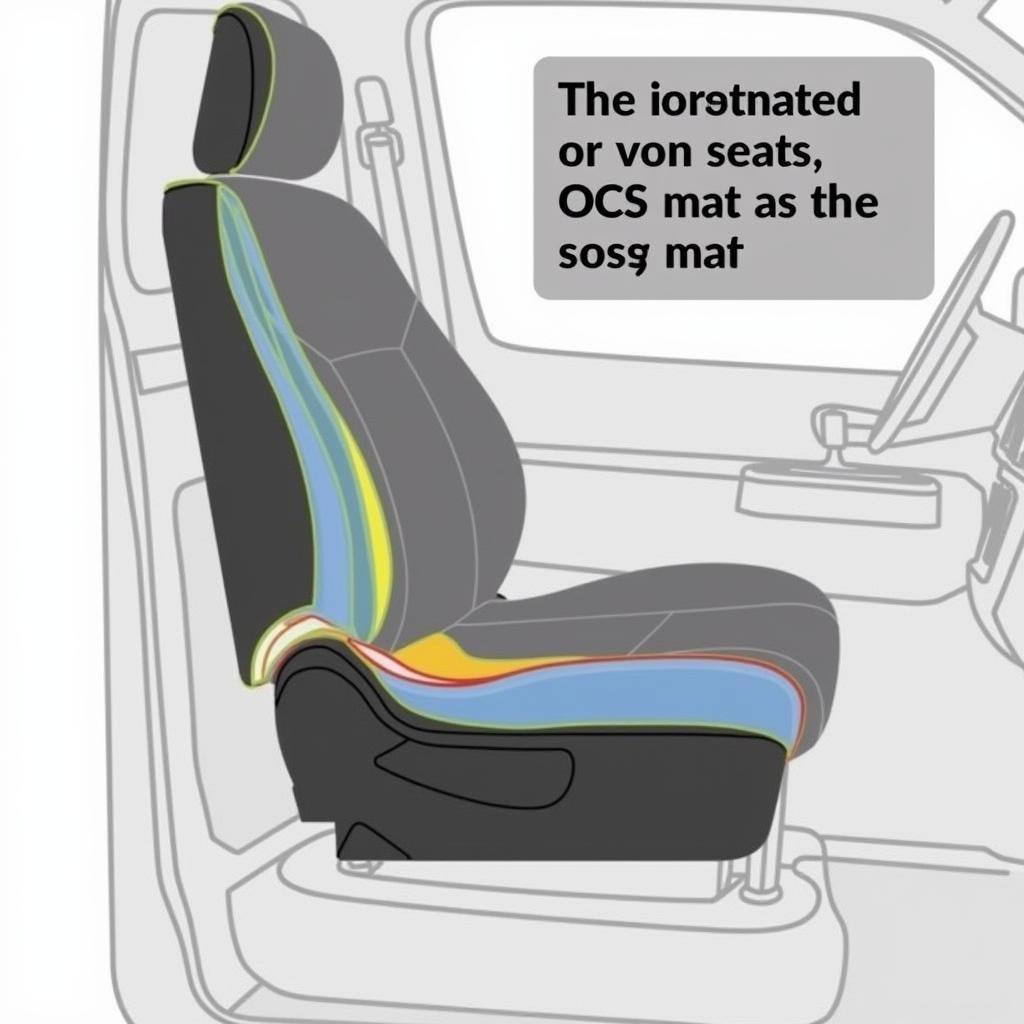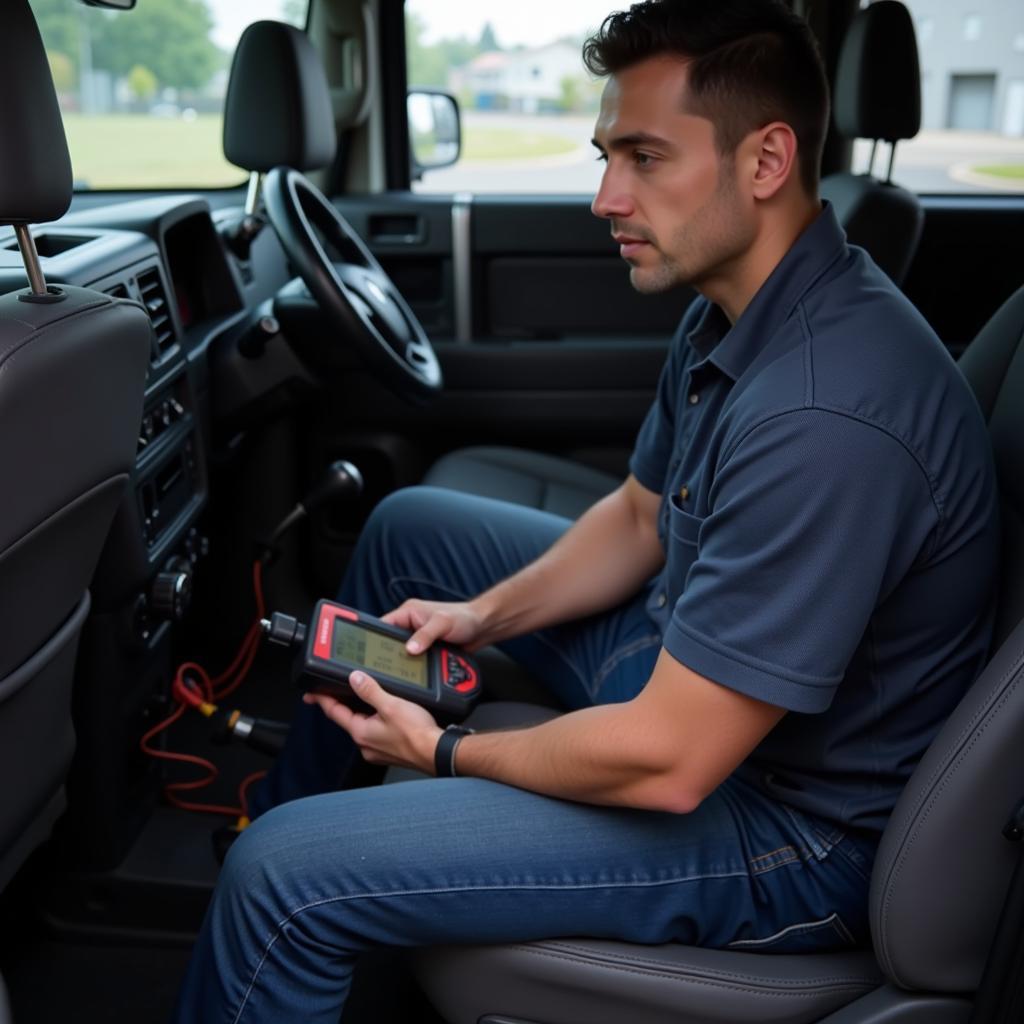The dreaded “23 and 60 lb van buckle in seat warning” can be a frustrating experience for any van owner. This guide dives deep into the causes of this warning, provides diagnostic and troubleshooting steps, and offers solutions to help you address this issue effectively, whether you’re a seasoned mechanic or a DIY enthusiast.
Understanding the 23/60 lb Weight Limit Warning
This warning is a crucial safety feature tied to your van’s airbag system. It’s designed to protect smaller passengers (typically children) from airbag deployment injuries. The system uses sensors in the passenger seat to detect the weight of the occupant. When the weight falls within the 23-60 lb range, the warning is triggered, indicating that the front passenger airbag may be dangerous for someone in that weight range. The system may automatically disable the airbag, or it may display a warning message urging you to buckle the occupant in a child restraint system.
Common Causes of the 23 and 60 lb Warning
Several factors can trigger this warning, even if there’s no one sitting in the passenger seat. These include:
- Faulty Occupancy Sensor: The most common culprit is a malfunctioning occupancy sensor mat (OCS mat) located within the passenger seat. This sensor can become damaged or worn over time, sending inaccurate readings to the airbag control module.
- Wiring Issues: Damaged or corroded wiring connections to the OCS mat can also disrupt the signal and cause the warning light.
- Software Glitches: Sometimes, a software glitch within the vehicle’s control module can trigger the warning erroneously.
- Aftermarket Seat Covers: Thick or improperly installed seat covers can interfere with the OCS mat’s ability to detect weight accurately.
 Van Seat Occupancy Sensor Location
Van Seat Occupancy Sensor Location
Diagnosing the 23/60 lb Warning: A Step-by-Step Guide
- Check the Passenger Seat: Ensure there are no objects on the passenger seat that might be triggering the sensor. Even a bag or laptop can sometimes be enough to activate the warning.
- Inspect the Seat Cover: If you have an aftermarket seat cover, temporarily remove it to see if the warning disappears. This will help determine if the seat cover is interfering with the sensor.
- Check the Wiring: Visually inspect the wiring connections under the passenger seat for any signs of damage, corrosion, or loose connections.
- Diagnostic Scan: The most accurate way to diagnose the problem is to use a professional-grade diagnostic scanner. This scanner can read the fault codes stored in the airbag control module, pinpointing the exact cause of the warning.
 OBD2 Scanner Diagnosing Van Seat Issue
OBD2 Scanner Diagnosing Van Seat Issue
Solutions and Repair Options
Depending on the diagnosis, several solutions are available:
- OCS Mat Replacement: If the OCS mat is faulty, it needs to be replaced. This is a relatively straightforward procedure for experienced DIYers, but professional installation is recommended for those unfamiliar with automotive electrical systems.
- Wiring Repair: Damaged or corroded wiring needs to be repaired or replaced. This requires careful attention to detail and proper soldering techniques.
- Software Update: In some cases, a software update from the vehicle manufacturer can resolve software-related glitches that trigger the warning.
- Remote Diagnostics and Programming: Modern technology allows for remote diagnostics and software updates. A qualified technician can remotely access your vehicle’s computer system, diagnose the issue, and even perform software updates or programming fixes without needing physical access to your van.
“Remote diagnostics and programming can save van owners significant time and money,” says John Miller, Senior Automotive Electrical Systems Engineer at AutoTech Solutions. “By eliminating the need for a physical visit to a repair shop, we can often resolve these issues quickly and efficiently.”
 Remote Diagnostics of Van Seat Issue
Remote Diagnostics of Van Seat Issue
Conclusion
Addressing the “23 and 60 lb van buckle in seat warning” is crucial for passenger safety. By understanding the causes, following the diagnostic steps, and exploring the available solutions, you can effectively resolve this issue and ensure the proper functioning of your van’s safety systems. Don’t ignore this warning; take action to ensure the safety of your passengers.
“Regularly checking your vehicle’s safety systems, including the occupancy sensor, is an important part of preventative maintenance,” adds Sarah Johnson, Lead Technician at AutoSafe Diagnostics. “This can help identify potential issues early on and prevent more costly repairs down the road.”
FAQ
- Can I disable the 23/60 lb warning myself? Tampering with the airbag system is strongly discouraged. It’s best to have a qualified technician diagnose and repair the issue.
- How much does it cost to replace an OCS mat? The cost varies depending on the make and model of your van but typically ranges from $100 to $300, including parts and labor.
- Is it safe to drive with the 23/60 lb warning on? While the vehicle may still be drivable, the airbag system may not function correctly. It’s important to address the issue promptly to ensure passenger safety.
- How can remote diagnostics help with this issue? Remote diagnostics can quickly identify the cause of the warning and, in some cases, even resolve the issue through software updates or programming adjustments without requiring a physical visit to a repair shop.
- What if the warning persists after replacing the OCS mat? If the warning persists, further diagnostics are needed. There might be underlying wiring issues or problems with the airbag control module.
- Can aftermarket seat heaters affect the OCS mat? Yes, improperly installed aftermarket seat heaters can sometimes interfere with the OCS mat’s operation.
- Is the 23/60 lb warning required by law? Yes, it’s a mandatory safety feature regulated by safety standards in many countries.


